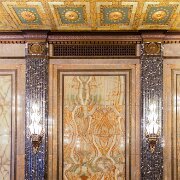
2 The Fisher Building (1928) is a landmark skyscraper in the United States, located in the heart of the New Center area of Detroit, Michigan. The ornate building is designed in an Art Deco style, constructed of limestone, granite, and several types of marble. The Fisher family financed the building with proceeds from the sale of Fisher Body to General Motors. It was designed to house office and retail space.
The building, which contains the elaborate 2,089 seat Fisher Theatre, was designated a National Historic Landmark on June 29, 1989
The building, which contains the elaborate 2,089 seat Fisher Theatre, was designated a National Historic Landmark on June 29, 1989
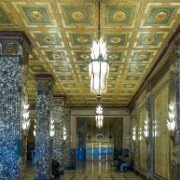
3 The Fisher Building (1928) is a landmark skyscraper in the United States, located in the heart of the New Center area of Detroit, Michigan. The ornate building is designed in an Art Deco style, constructed of limestone, granite, and several types of marble. The Fisher family financed the building with proceeds from the sale of Fisher Body to General Motors. It was designed to house office and retail space.
The building, which contains the elaborate 2,089 seat Fisher Theatre, was designated a National Historic Landmark on June 29, 1989
The building, which contains the elaborate 2,089 seat Fisher Theatre, was designated a National Historic Landmark on June 29, 1989
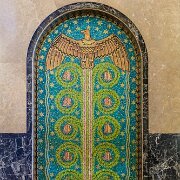
4 The Fisher Building (1928) is a landmark skyscraper in the United States, located in the heart of the New Center area of Detroit, Michigan. The ornate building is designed in an Art Deco style, constructed of limestone, granite, and several types of marble. The Fisher family financed the building with proceeds from the sale of Fisher Body to General Motors. It was designed to house office and retail space.
The building, which contains the elaborate 2,089 seat Fisher Theatre, was designated a National Historic Landmark on June 29, 1989
The building, which contains the elaborate 2,089 seat Fisher Theatre, was designated a National Historic Landmark on June 29, 1989
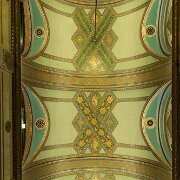
5 The Fisher Building (1928) is a landmark skyscraper in the United States, located in the heart of the New Center area of Detroit, Michigan. The ornate building is designed in an Art Deco style, constructed of limestone, granite, and several types of marble. The Fisher family financed the building with proceeds from the sale of Fisher Body to General Motors. It was designed to house office and retail space.
The building, which contains the elaborate 2,089 seat Fisher Theatre, was designated a National Historic Landmark on June 29, 1989
The building, which contains the elaborate 2,089 seat Fisher Theatre, was designated a National Historic Landmark on June 29, 1989

6 The Fisher Building (1928) is a landmark skyscraper in the United States, located in the heart of the New Center area of Detroit, Michigan. The ornate building is designed in an Art Deco style, constructed of limestone, granite, and several types of marble. The Fisher family financed the building with proceeds from the sale of Fisher Body to General Motors. It was designed to house office and retail space.
The building, which contains the elaborate 2,089 seat Fisher Theatre, was designated a National Historic Landmark on June 29, 1989
The building, which contains the elaborate 2,089 seat Fisher Theatre, was designated a National Historic Landmark on June 29, 1989
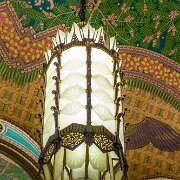
7 The Fisher Building (1928) is a landmark skyscraper in the United States, located in the heart of the New Center area of Detroit, Michigan. The ornate building is designed in an Art Deco style, constructed of limestone, granite, and several types of marble. The Fisher family financed the building with proceeds from the sale of Fisher Body to General Motors. It was designed to house office and retail space.
The building, which contains the elaborate 2,089 seat Fisher Theatre, was designated a National Historic Landmark on June 29, 1989
The building, which contains the elaborate 2,089 seat Fisher Theatre, was designated a National Historic Landmark on June 29, 1989
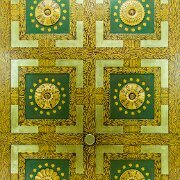
8 The Fisher Building (1928) is a landmark skyscraper in the United States, located in the heart of the New Center area of Detroit, Michigan. The ornate building is designed in an Art Deco style, constructed of limestone, granite, and several types of marble. The Fisher family financed the building with proceeds from the sale of Fisher Body to General Motors. It was designed to house office and retail space.
The building, which contains the elaborate 2,089 seat Fisher Theatre, was designated a National Historic Landmark on June 29, 1989
The building, which contains the elaborate 2,089 seat Fisher Theatre, was designated a National Historic Landmark on June 29, 1989

9 The Fisher Building (1928) is a landmark skyscraper in the United States, located in the heart of the New Center area of Detroit, Michigan. The ornate building is designed in an Art Deco style, constructed of limestone, granite, and several types of marble. The Fisher family financed the building with proceeds from the sale of Fisher Body to General Motors. It was designed to house office and retail space.
The building, which contains the elaborate 2,089 seat Fisher Theatre, was designated a National Historic Landmark on June 29, 1989
The building, which contains the elaborate 2,089 seat Fisher Theatre, was designated a National Historic Landmark on June 29, 1989

10 The Fisher Building (1928) is a landmark skyscraper in the United States, located in the heart of the New Center area of Detroit, Michigan. The ornate building is designed in an Art Deco style, constructed of limestone, granite, and several types of marble. The Fisher family financed the building with proceeds from the sale of Fisher Body to General Motors. It was designed to house office and retail space.
The building, which contains the elaborate 2,089 seat Fisher Theatre, was designated a National Historic Landmark on June 29, 1989
The building, which contains the elaborate 2,089 seat Fisher Theatre, was designated a National Historic Landmark on June 29, 1989
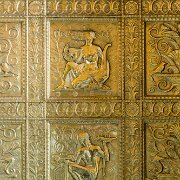
11 The Fisher Building (1928) is a landmark skyscraper in the United States, located in the heart of the New Center area of Detroit, Michigan. The ornate building is designed in an Art Deco style, constructed of limestone, granite, and several types of marble. The Fisher family financed the building with proceeds from the sale of Fisher Body to General Motors. It was designed to house office and retail space.
The building, which contains the elaborate 2,089 seat Fisher Theatre, was designated a National Historic Landmark on June 29, 1989
The building, which contains the elaborate 2,089 seat Fisher Theatre, was designated a National Historic Landmark on June 29, 1989

12 The Fisher Building (1928) is a landmark skyscraper in the United States, located in the heart of the New Center area of Detroit, Michigan. The ornate building is designed in an Art Deco style, constructed of limestone, granite, and several types of marble. The Fisher family financed the building with proceeds from the sale of Fisher Body to General Motors. It was designed to house office and retail space.
The building, which contains the elaborate 2,089 seat Fisher Theatre, was designated a National Historic Landmark on June 29, 1989
The building, which contains the elaborate 2,089 seat Fisher Theatre, was designated a National Historic Landmark on June 29, 1989

13 The Fisher Building (1928) is a landmark skyscraper in the United States, located in the heart of the New Center area of Detroit, Michigan. The ornate building is designed in an Art Deco style, constructed of limestone, granite, and several types of marble. The Fisher family financed the building with proceeds from the sale of Fisher Body to General Motors. It was designed to house office and retail space.
The building, which contains the elaborate 2,089 seat Fisher Theatre, was designated a National Historic Landmark on June 29, 1989
The building, which contains the elaborate 2,089 seat Fisher Theatre, was designated a National Historic Landmark on June 29, 1989
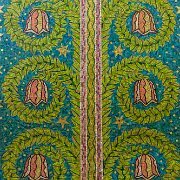
14 The Fisher Building (1928) is a landmark skyscraper in the United States, located in the heart of the New Center area of Detroit, Michigan. The ornate building is designed in an Art Deco style, constructed of limestone, granite, and several types of marble. The Fisher family financed the building with proceeds from the sale of Fisher Body to General Motors. It was designed to house office and retail space.
The building, which contains the elaborate 2,089 seat Fisher Theatre, was designated a National Historic Landmark on June 29, 1989
The building, which contains the elaborate 2,089 seat Fisher Theatre, was designated a National Historic Landmark on June 29, 1989
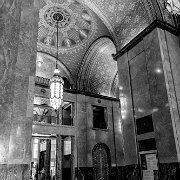
15 The Fisher Building (1928) is a landmark skyscraper in the United States, located in the heart of the New Center area of Detroit, Michigan. The ornate building is designed in an Art Deco style, constructed of limestone, granite, and several types of marble. The Fisher family financed the building with proceeds from the sale of Fisher Body to General Motors. It was designed to house office and retail space.
The building, which contains the elaborate 2,089 seat Fisher Theatre, was designated a National Historic Landmark on June 29, 1989
The building, which contains the elaborate 2,089 seat Fisher Theatre, was designated a National Historic Landmark on June 29, 1989
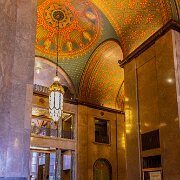
16 The Fisher Building (1928) is a landmark skyscraper in the United States, located in the heart of the New Center area of Detroit, Michigan. The ornate building is designed in an Art Deco style, constructed of limestone, granite, and several types of marble. The Fisher family financed the building with proceeds from the sale of Fisher Body to General Motors. It was designed to house office and retail space.
The building, which contains the elaborate 2,089 seat Fisher Theatre, was designated a National Historic Landmark on June 29, 1989
The building, which contains the elaborate 2,089 seat Fisher Theatre, was designated a National Historic Landmark on June 29, 1989
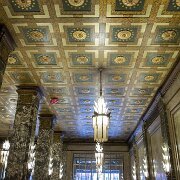
17 The Fisher Building (1928) is a landmark skyscraper in the United States, located in the heart of the New Center area of Detroit, Michigan. The ornate building is designed in an Art Deco style, constructed of limestone, granite, and several types of marble. The Fisher family financed the building with proceeds from the sale of Fisher Body to General Motors. It was designed to house office and retail space.
The building, which contains the elaborate 2,089 seat Fisher Theatre, was designated a National Historic Landmark on June 29, 1989
The building, which contains the elaborate 2,089 seat Fisher Theatre, was designated a National Historic Landmark on June 29, 1989

18 The Fisher Building (1928) is a landmark skyscraper in the United States, located in the heart of the New Center area of Detroit, Michigan. The ornate building is designed in an Art Deco style, constructed of limestone, granite, and several types of marble. The Fisher family financed the building with proceeds from the sale of Fisher Body to General Motors. It was designed to house office and retail space.
The building, which contains the elaborate 2,089 seat Fisher Theatre, was designated a National Historic Landmark on June 29, 1989
The building, which contains the elaborate 2,089 seat Fisher Theatre, was designated a National Historic Landmark on June 29, 1989

19 The Fisher Building (1928) is a landmark skyscraper in the United States, located in the heart of the New Center area of Detroit, Michigan. The ornate building is designed in an Art Deco style, constructed of limestone, granite, and several types of marble. The Fisher family financed the building with proceeds from the sale of Fisher Body to General Motors. It was designed to house office and retail space.
The building, which contains the elaborate 2,089 seat Fisher Theatre, was designated a National Historic Landmark on June 29, 1989
The building, which contains the elaborate 2,089 seat Fisher Theatre, was designated a National Historic Landmark on June 29, 1989
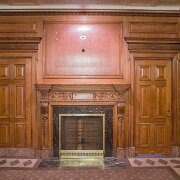
20 The Fisher Building (1928) is a landmark skyscraper in the United States, located in the heart of the New Center area of Detroit, Michigan. The ornate building is designed in an Art Deco style, constructed of limestone, granite, and several types of marble. The Fisher family financed the building with proceeds from the sale of Fisher Body to General Motors. It was designed to house office and retail space.
The building, which contains the elaborate 2,089 seat Fisher Theatre, was designated a National Historic Landmark on June 29, 1989
The building, which contains the elaborate 2,089 seat Fisher Theatre, was designated a National Historic Landmark on June 29, 1989

Buildings, Details